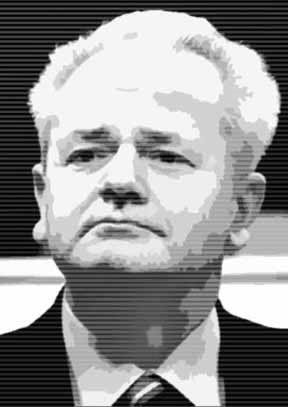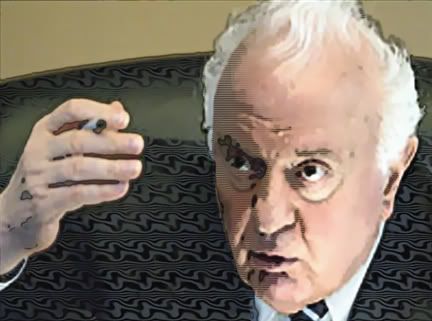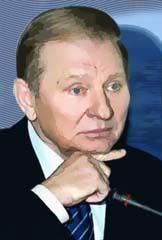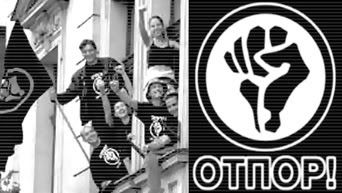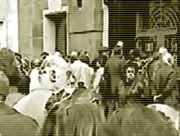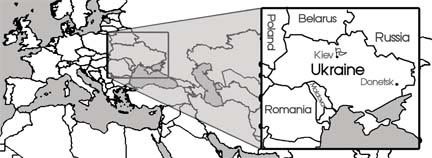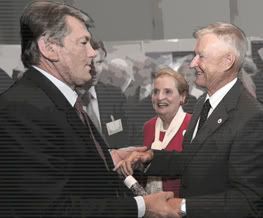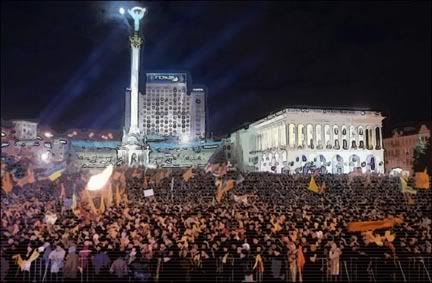OLIGARCHS, COLLAPSE, BAILOUT... THEN REVIVAL
Adam Larson
Caustic Logic / Guerillas Without Guns
Re-posted 2/17/07For Washington and London, the ability to start making these
pipeline power plays was both an effect and hopefully a further cause of Russia’s diminished regional power. Behind this seems to be a campaign to drag the Eurasian giant into the Euro-Atlantic Community kicking and foaming at the mouth if need be, an aim laid out well by Brzezinski in 1997: “Russia’s only real geostrategic option – the option that could give Russia a realistic international role and also maximize the opportunity of transforming and socially modernizing itself - is […] the transatlantic Europe of the enlarging EU and NATO.” Russia should follow this lead, Brzezinski warned, if it wanted to avoid “a dangerous geopolitical isolation.” [1]
But the exact terms of integration remained unclear; Russians somehow took Washington’s talk around 1992-93 of a “mature strategic partnership” as a revival of Gorbachev’s “new world order” scenario, a more-or-less co-equal global alliance of mutually existing great powers. Fawning praise, false promises, and the opening of economies ensued in a long and nearly snuggly phase that allowed what Brzezinski summed up as the Russian street’s expectation of “a global condominium.” Zbig noted in retrospect:
“The problem with this approach was that it was devoid of either international or domestic realism. While the concept of a “mature strategic partnership” was flattering, it was also deceptive. America was neither inclined to share global power with Russia nor could it, even if it had wanted to. […] once differences inevitably started to surface, the disproportion in political power, financial clout, technological innovation and cultural appeal made the “mature strategic partnership” seem hollow – and it struck an increasing number of Russians as deliberately designed to deceive Russia.” [2]
So it was not America’s fault, but the fact that Russia was simply not up to the role. But the 1990s did see economic liberalization in Yeltsin’s Russia, with the widespread privatization of the previously state-run enterprises and moves towards a full market economy, openness to foreign investment, and general integration with the Western system. The major enterprises were taken over by a new generation of Russian capitalist pioneers and black-marketeers known as “the Oligarchs.” First introduced to the scene by Gorbachev in the late 1980s under his perestroika campaign, President Yeltsin supported this process and provided the Oligarchs with rich pickings, and the very small group soon acquired vast interests in all sectors of the economy. But in the end analysis, everyone agrees that the oligarchs did not rescue the Russian economy but rather bled it dry. Journalist Ann Williamson, author of How America Built the New Russian Oligarchy, explained to the House Committee on Banking in her September 1999 testimony:
“Directors stashed profits abroad, withheld employees’ wages, and after cash famine set in, used those wages, confiscated profits and state subsidies to ‘buy’ the workers’ shares from them. The really good stuff – oil companies, metal plants, telecoms – was distributed to essentially seven individuals, ‘the oligarchs,’ on insider auctions whose results were guaranteed beforehand. Once effective control was established, directors - uncertain themselves of the durability of their claim to newly acquired property - chose to asset strip with impunity instead of developing their new holdings.” [3]
Profits thus gained were laundered and deposited safely in Western bank accounts outside of Russia’s reach, with the depositors sometimes following their money out the door. Passed off as the result of mismanagement and shortsighted greed, the draining of Russia’s treasury is usually termed as “capital flight,” a rather passive sounding process. But investigator Michael Ruppert sees geopolitics at work in this “scheme to loot Russia’s wealth and park it in the west.” Once they were granted positions of economic power, Ruppert maintained in his 2004 book Crossing the Rubicon that “the Empire loved the oligarchs because they were simple and could be easily controlled with money.” [4]
Ruppert also noted how the “assistance” program to usher Russia into capitalism took off under the Clinton administration in 1993. A team headed by vice president Al Gore worked in concert with Goldman Sachs, Harvard’s Institute for International Development, the IMF, and the World Bank. This team, as Ruppert summarized, “worked in partnership with the government of Boris Yeltsin to re-make the Russian economy. What happened was that Russia, in the words of Yeltsin himself, became a “mafiocracy” and was looted of more than 500 billion in assets, and its ability to support a world-class military establishment smashed.” [5] What a convenient turn of events against this recently identified potential rival.
Yeltsin had initially renounced all claim to former Soviet glory and empire: “Russia does not aspire to become the center of some sort of new empire […] history has taught us that a people that rules over others cannot be fortunate.” [6] But by 1997 as Brzezinski wrote his book, new ideas about Russia’s role were starting to gel in Moscow that showed signs of renewed ambition. Straddling the boundary between Europe and Asia, the idea of a special “Eurasianism” took hold; as Yeltsin’s former Vice President Aleksandr Rustkoi explained “Russia represents the only bridge between Asia and Europe. Whoever becomes the master of this space will become the master of the world.” [7] Foreign Minister Andrei Kozyrev said at around this time Russia “must preserve its military presence in regions that have been in its sphere of interests for centuries.” [8]
But not much was possible with the economy still in a weak transitional state. The first slight economic recovery began in 1997, but this was cut short by the Asian financial crisis that hit its markets late in the year. The nation toughed out the financial burden through the first half of 1998, but things got edgy as the money dried up. In May a campaign of pensioner’s strikes was joined by miner’s strikes and others – the people took matters into their own hands, blocking railway lines to demand unpaid back wages. Communist leader Gennady Zyuganov led the growing calls for Yeltsin and his newly-appointed PM Sergei Kiryenko to resign. [9]
Perhaps in desperation, Russia finally turned to the West and sought an IMF bailout, what Ruppert calls “the kiss of death for any country.” [10] The IMF reported it was strapped, and “entering a region in terms of our financing where we are in grave difficulties.” [11] Washington feared the alternative – a Russian devaluation of the ruble (their equivalent of the dollar), leading to an international financial chain reaction. [12] On July 20, the IMF Executive Board approved its portion ($11.2 billion) of a $22.6 billion international bailout. This emergency package was intended to help Russia maintain the value of the ruble while the government implemented reforms necessary to create long-term stability.
| Muscovites line up to get their money out of the bank before the economy crashes, 1998 |
On August 14, president Yeltsin assured the west that the loan had worked, stating clearly that the ruble would not be devalued. But a bare three days later, PM Kiriyenko announced that the government would devalue the ruble after all, by a stunning 34 percent, and declared a 90-day foreign debt moratorium. The bottom dropped from beneath the Russian economy that very day, leading to a total collapse comparable to the crash that hit America’s markets in 1929.
Mass unemployment and a sharp fall in living standards for most of the population ensued. Unemployment, hunger, homelessness, and related social problems wracked the region in late 1998. CNN billed “Russia’s year of agony” as one of the top ten stories of the year, and it also spread into neighboring countries like Ukraine, Belarus and Moldova, that remained tangled with their neighbor’s economy. Many in Washington were furious; Ariel Cohen and Brett Schaefer of the Heritage Foundation noted “it is now painfully clear […] that the massive bailout failed in both of its missions: The ruble was devalued, and reforms are not likely to be implemented.” Cohen and Schaefer blamed Russia for failing to reform its economy and the IMF for consistently loaning to them anyway, calling on Congress to cut off funding to the fund. [13]
The crisis did not last too long though on the Russian end; by whatever connection, it was only after the loan and the devaluation of the ruble and the debt default that Russia’s economy began improving on the back of strong gas exports in 1999. The weak ruble made imports expensive and boosted local production, creating greater self-reliance or “autarky,” the opposite of the economic “dependency model” behind the western system. Russia entered a phase of rapid economic expansion, the GDP growing by an average of 6.7% annually in 1999-2005 on the back of higher oil prices, a weaker ruble, and increasing industrial output. It has gone from bankruptcy to large foreign reserves, and by 2001 Russia was seen as a major rising player on the world scene for the first time in nearly a decade. In retrospect the IMF episode almost looks like a grand kiss-off to the West: “Thanks for the so-called assistance, comrades, but we’ll just recover what we can and manage it ourselves from there...”
Behind the official reasons for the 1998 bailout there had been deeper fears than the value of the ruble. The youngest and richest among the economy draining Russian Oligarchs is Roman Abramovich, in 2006 Russia’s richest man and the 11th richest person in the world, worth $18.2 billion. [14] Abramovich is a proud Jew and supporter of Israel, and he’s not alone; the top tier of Oligarchs were primarily Jews, a fact that contributed negatively to a trend all too familiar from the history books: a nation in crisis after losing a major struggle, feeling betrayed by the West and turning to renewed nationalist glory and – at least in certain cases - increased suspicion of the Jews among them. The specific anti-Semitism has of course become highly unpopular since the Holocaust, and precise charges have remained muted – but overall a repeat of Germany circa 1932 seemed a danger; the British free trade magazine
The Economist ran a story on July 15 warning that an abrupt devaluation:
“could spell doom for the banking system, bring down the Kiriyenko government and, as one American diplomat put it, ‘signal the end of liberal Russia.’ […] Might the deadly mixture of economic chaos, public anger and sense of national humiliation that fuelled fascism in Weimar Germany flare up in Russia now? […] Such fears appear to have been taken seriously enough in Washington for the US administration to deem the situation in Russia to be a global strategic threat."[15]
Five days after this story ran the package was approved, but on this front as well the bailout seems to have had little effect. Prime Minister Kiriyenko was sacked in August. Yeltsin tried to bring back his predecessor Viktor Chernomyrdin, but in September compromised on Yevgeniy Primakov. In May 1999 Yeltsin sacked Primakov, replacing him with Sergey Stepashin, who served until August when Yeltsin replaced him with rising star Vladimir Putin. Putin was thus the fifth PM in eighteen particularly rough months, and as a relative unknown, seemed an expendable who likewise would be sacked in due time. But he found a lever that allowed him to stay on, and by the estimates of a growing body of opinion, the feared fascist regime came to power in Moscow despite the best efforts of the internationalists.
Next:
Terror of 9/99, Putin Ascendant
Sources:
[1] Brzezinski p. 118.
[2] Brz 100-101
[3] Williamson, Anne. “The Rape of Russia.” Testimony before Committee on Banking and financial Services, US House of Representatives. September 21 1999. http://www.russians.org/williamson_testimony.htm
[4] Ruppert - Crossing the Rubicon - easily controlled with money
[5] Ruppert page 88
[6] Brzezinski p 99.
[7] BRZ 109.
[8] Brz 107
[9] “Russian Trains: New Kiriyenko government faces first major test.” CNN. May 20, 1998. http://cnn.hu/WORLD/europe/9805/20/russia.govt.crisis/
[10] Ruppert – kiss of death
[11], [12] IMF protected US banks in Russian bailout. By Nick Beams. 21 July 1998. World Socialist Web Site. http://www.wsws.org/news/1998/july1998/rus-j21.shtml
[13] "The IMF's $22.6 Billion Failure in Russia." Ariel Cohen, Ph.D., and Brett D. Schaefer. Heritage Foundation Executive Memorandum #548. http://www.heritage.org/Research/RussiaandEurasia/em548.cfm
[14] http://en.wikipedia.org/wiki/Roman_Abramovich
[15] IMF protected US banks in Russian bailout. By Nick Beams. 21 July 1998. World Socialist Web Site. http://www.wsws.org/news/1998/july1998/rus-j21.shtml
 Mass protests in front of the Parliament building, Belgrade, Oct. 5 2000.
Mass protests in front of the Parliament building, Belgrade, Oct. 5 2000. 
